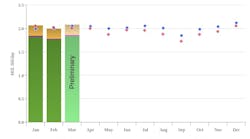Guntis Moritis
Production Editor
SAN ANTONIO, Oct. 1 -- Monitoring microseismic and tilt meter events can help a company understand the geometry of the fractures created by hydraulic stimulations. Use of these tools has shown that hydraulic fractures can grow asymmetrically, have variable confinement across geologic interfaces, and change orientation, as explained in several presentations at the 2002 Society of Petroleum Engineers Annual Technical Conference & Exhibition in San Antonio.
S.C. Maxwell, Engineering Seismology Group, Kingston, Ont., said that microseismic tools have monitored hydraulic fracture growth for several Barnett shale hydraulic treatments performed during March 2000-December 2001. Typical Barnett shale stimulation jobs involve about 750,000 gal of slickwater and 80,000 lb of proppant pumped at 60 bbl/min with low proppant concentrations of 0.1-0.5 ppg.
The Barnett is a tight, naturally fractured, abnormally pressured shale gas reservoir in the Fort Worth basin of north central Texas and comprises the Mississippian shale lying between the Viola and Marble Falls limestones. The 200-800 ft thick shale has permeabilities ranging from 0.00007 to 0.005 md.
Maxwell said that the microseismic images explain why the stimulations occasionally grow at an angle to the assumed fracture orientation and into neighboring wells. He indicated differences in well production rates could be related to the fracture geometry, and by understanding these fracture networks operators can avoid drilling infill wells that overlap already drained areas.
C.A. Wright, president of Pinnacle Technologies Inc., San Francisco, explained how the Barnett shale benefits from fracture treatments that establish long and wide fracture fairways, which result in connecting very large surface areas of the formation with an extremely complex fracture network.
He said that with integrated fracture diagnostics from surface tilt meters and microseismic events, one can create detailed maps of the complex fracture geometry that can be used for calibrating 3D fracture simulators to better reflect the fracturing mechanics.
Wright said that surface tilt mapping is a direct fracture diagnostic tool used on more than 1,000 treatments/year to map deformation caused at the surface of the earth by hydraulic fractures or dislocations in the subsurface.
The technology includes both surface and downhole tiltmeters.
Surface tiltmeters measure gradient displacement of about 1 ppb and provide data to directly determine the azimuth and dip of a hydraulic fracture, as well as the percent of treatment volume placed in each plane or orientation when fracture growth occurs in multiple planes.
Wright described downhole tilt mapping as a separate application that uses ruggedized surface tiltmeter instruments and places them in wellbores offsetting the treatment wells. To measure fracture length, one places downhole tiltmeter arrays in the general expected fracture-propagation direction.
